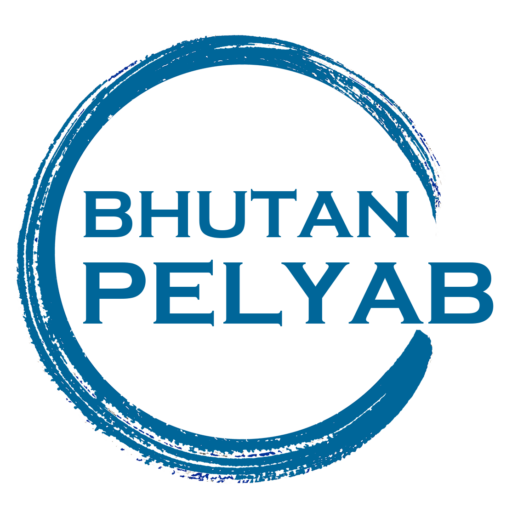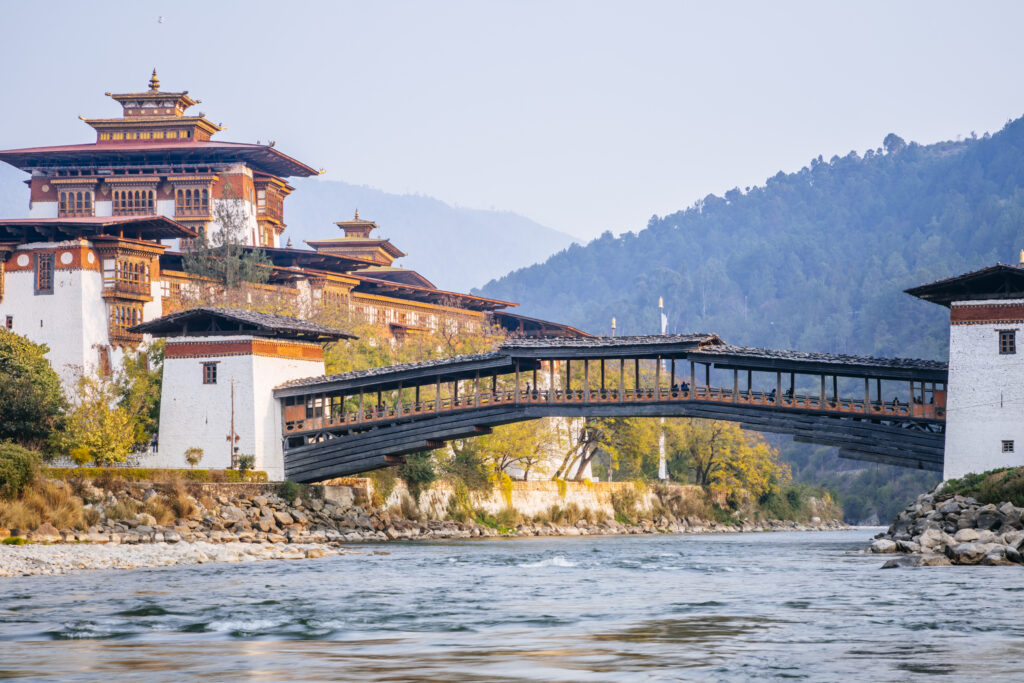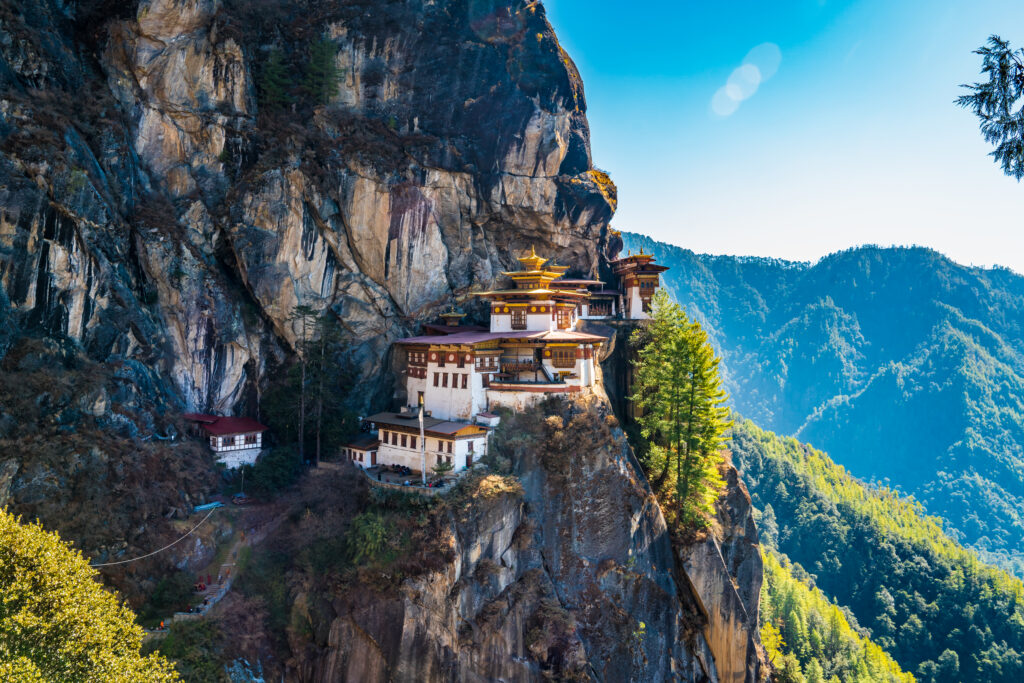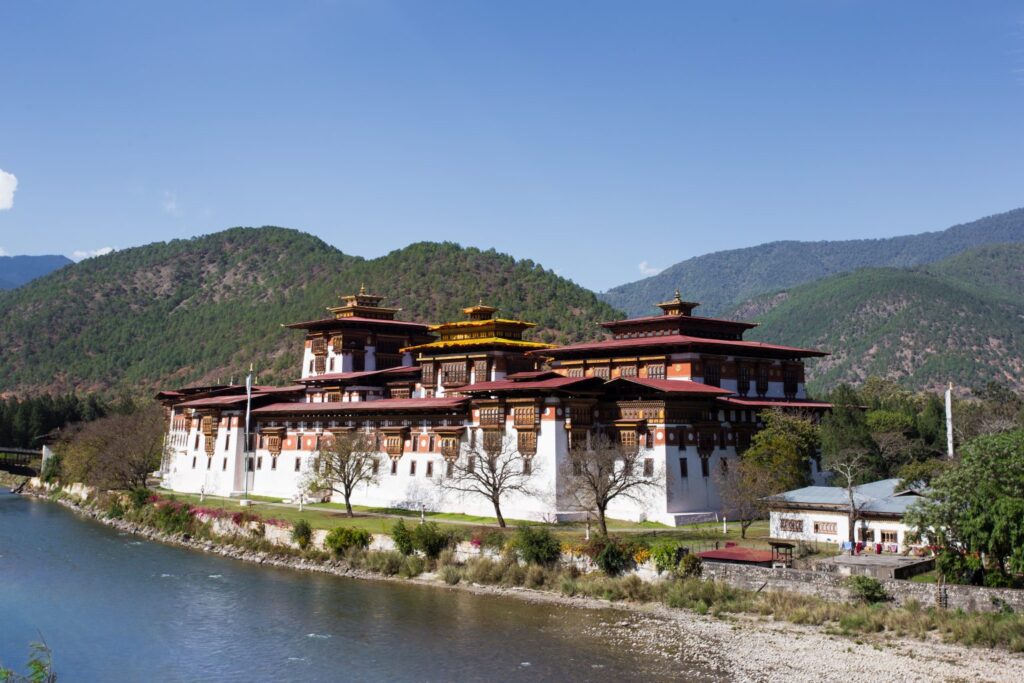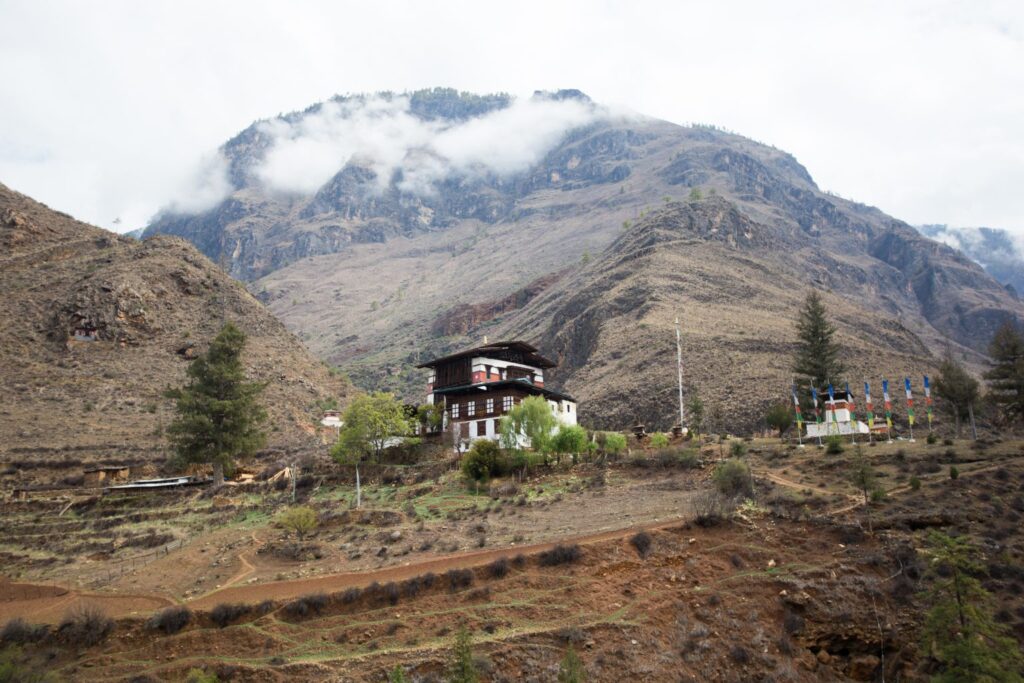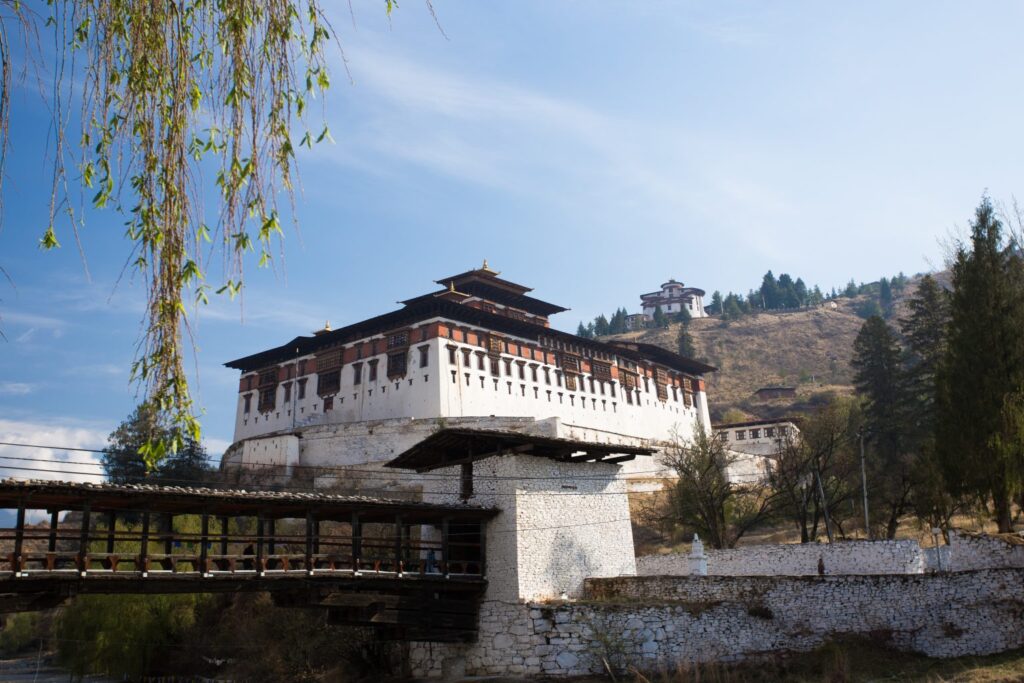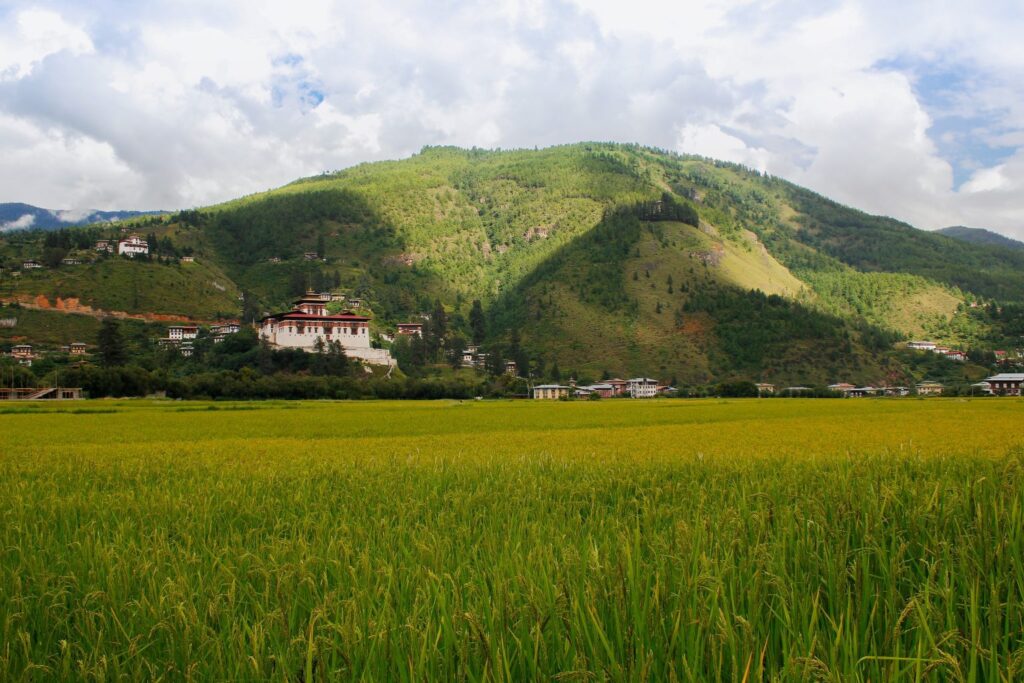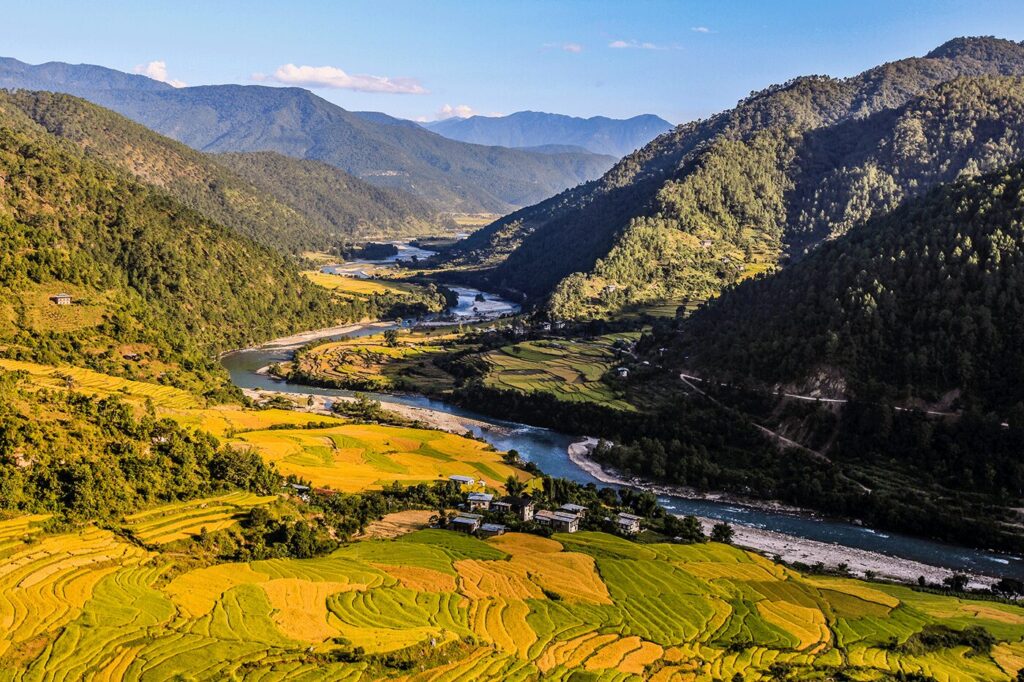Day 01: Arrive in Paro and drive to Thimphu
- Altitude in Paro: 2,300m
- Altitude in Thimphu: 2,400m
- Distance: 55km
- Estimated travel time: 1.30hrs
When your plane is approaching Paro, make sure to enjoy the view of Himalayan snowcapped peaks from above. After meeting with our representative, you will travel to the capital city – Thimphu. On the way, we can make a quick visit to Tachogang Lhakhang (Temple of The Excellent Horse). The legendary Bhutanese bridge builder Thangtong Gyalpo (1385-1464) erected it following his vision of the spiritual horse Balaha – an emanation of Avalokiteshvara.
Upon reaching Thimphu, we will check-in at the hotel and visit the National Memorial Chorten. It was the idea of Bhutan’s Third King, His Majesty Jigme Dorji Wangchuk – a site dedicated to world peace and prosperity. It later became a memorial to the Late King as well.
At the next stop – the General Post Office, you can make your own stamp and keep it as a unique souvenir.
We will then head to the largest statue of Bhutan – Buddha Point (Buddha Dordenma Statue). Standing on top of a hill in Kuenselphodrang Nature Park, the 51.5m statue is made of bronze and is gilded in gold. It is believed to radiate an aura of peace and happiness to the entire world. There are 125,000 smaller Buddha statues placed within the massive statue.
The first day will end with the Wangditse Nature hike (2,400m) in Motithang, a north-western suburb of Thimphu. On the 2.5km hike, we will cross forests of oaks, blue pines, and rhododendrons. It will take about 2 hours to finish the hike. The trail is decorated with colorful prayer flags and as we look back, we can have the picturesque view of the Samteling Palace, Tashichho Dzong, and the whole of Thimphu Valley. We will also visit Motithang Takin Preserve (Royal Takin Preserve) to see Takin – Bhutan’s national animal, and Druk Wangditse Lhakhang temple, one of the oldest temples in Thimphu, and considered an important heritage site of Bhutan.
We will then return to Thimphu city and spend the first night at the hotel here.
Day 02: Discover Thimphu
We will have a tasty breakfast before hiking to Cheri Goemba. At 2,800m, it is the first monastery of Bhutan, founded in 1620. The trail will take about 1 hour to finish with an elevation gain of 400m. The trail will lead us through a lush forest of firs, rhododendron trees, and blue pines. The monastery became famous after it was visited by Guru Padmasambava and is a favored sightseeing place for travelers, from where you will have a pictorial view of Thimphu.
We will understand more about Bhutanese life and art by visiting the Folk Heritage Museum and the National Textile Museum. Designed as a traditional rural house from the 19th century, the heritage museum is an interesting place where daily objects like the leopard-skin bags and Brokpa yak-hair ‘spider’ hats are displayed. And at the textile museum, we will see the practicing of thagzo (weaving) with various styles and on different materials.
If your trip falls on a weekend, we can spend time trolling around the farmer’s market. You can find all kinds of meats, vegetables, and even incense from all over the country here. Then we can explore the dynamic Thimphu town to see the Bhutanese’s daily life.
The next stop is a photographer’s dream because of the impressive demonstration of traditional arts there. At the National Institute for Zorig Chusum, also called the ‘Arts And Crafts School’ or the ‘Painting School’, students practice Bhutanese traditional arts. You can see students practicing painting (thangkas – painted religious pictures, walls, and statues to the decorations on furniture and window-frames), woodcarving (masks, statues, bowls), or statue-making (clay).
Last destination for the day is the striking Tashichho Dzong (Fortress of The Glorious Religion). First being built in 1216 A.D, the dzong went through a number of reconstruction and was completely renovated by King Jigme Dorji Wangchuck after he moved the capital to Thimphu. The massive dzong is close to Thimphu town, and is also well-known for its charming scene of flag changing at 5pm. The ceremony begins in the courtyard and ends outside in the front of the dzong.
You will stay for another night at the hotel in Thimphu.
Day 03: Thimphu to Gangtey
- Altitude in Gangtey: 2,900m
- Distance: 160km
- Estimated travel time: 6hrs
We will travel to Gangtey today. On the way, we will visit Dochula pass (3,050m) and enjoy the panoramic view of the Himalayan ranges from here. On clear winter days, the sight is exceptionally beautiful with the 108 chortens gracing the mountain pass and the picturesque backdrop of snowcapped mountains.
Close to the chortens, there is a temple called Druk Wangyal Lhakhang, built in honor of His Majesty the fourth Druk Gyalpo, Jigme Singye Wangchuck.
The Wangdue Phodrang Dzong, established by Zhabdrung Ngawang Namgyal in 1638, rests on a ridge at the confluence of the Punak Tsang Chhu and Dang Chhu rivers. This historic fortress was a masterpiece of traditional Bhutanese architecture and a key link between eastern and western Bhutan during the early days.
According to local legend, the site was chosen after four ravens were spotted flying in four directions – an auspicious sign interpreted as the spread of Buddhist teachings across the land. After the establishment of Trongsa Dzong in 1644, the Penlop (governor) of Wangdue became one of the most powerful figures in Bhutan, controlling key trade routes to Trongsa, Punakha, Dagana and the capital Thimphu.
On 24th June 2012, a tragic fire reduced the dzong to ruins, destroying many irreplaceable relics housed within. His Majesty The King ordered its reconstruction, blending traditional craftsmanship with modern earthquake-resistant technology to ensure its resilience. The dzong was consecrated anew on 11th November 2022.
The new Dzong recreates the original design using authentic materials and methods by local artisans. But it also incorporates innovations like seismic base isolators and steel latches to strengthen floors and walls. Today, it houses salvaged relics and newly commissioned sacred artifacts, standing as a powerful symbol of Bhutan’s resilience, cultural preservation, and spiritual devotion.
From the Wangdue Phodrang Dzong, we will take a 20-minute walk to Rinchengang village. Alternatively, you can also visit the village by car.
Rinchengang is a small, clustered village renowned for its expertise in traditional stonework methods, a skill passed down through generations. Located on a small hill opposite the Wangdue Phodrang Dzong, the village offers an uninterrupted view of the majestic fortress. The Punatsangchhu River flows gracefully along the highway below, adding to the charm of the setting.
The name “Rinchengang” is believed to have originated from the term Drinchengang, meaning “grateful village.” According to oral tradition, the village’s ancestors were skilled masons who came to construct the Wangdue Phodrang Dzong during the time of Zhabdrung Ngawang Namgyal. After completing the fortress, they settled here, forming one of the oldest villages in Bhutan.
Rinchengang is unique for its closely packed two-storied traditional houses, mostly shared by multiple families. The villagers collectively own land and practice double cropping as part of their traditional way of life. Their expertise in masonry is evident in the intricate stonework of the houses, showcasing the craftsmanship that made them indispensable during the construction of the dzong.
For visitors, Rinchengang offers a glimpse into Bhutanese rural life and breathtaking views of the Wangdue Phodrang Dzong. The uphill walk from the Thimphu-Wangdue highway to the village adds a sense of adventure, making it a memorable experience for those who visit.
Once we reach Gangtey, we will head to Gangtey Goemba or ‘Gangtey monastery’. Established in 1613, the extensive complex is now an important monastery of Nyingmapa school of Buddhism. Located on a forested hill overlooking the Gangtey valley, the monastery offers the whole view of Gangtey valley’s green expanse. Gangtey valley (or ‘Phobjikha valley’) is also the winter home of the rare Black Necked Cranes.
You will stay overnight at the hotel in Gangtey.
Day 04: Gangtey sightseeing
Today’s journey will begin with a famous and pleasant hike – the Gangtey Nature Trail. It is a popular walk, especially for travelers to discover the lush Gangtey valley. From the small hilltop overlooking Gangtey Goemba, the trails will head down to beautiful flower meadows then to Semchubara village. After the village, we will continue and enjoy the fresh air when walking in the pristine forest of blue pines before arriving at a valley viewpoint. The walk will finish once we see the small Khewang Lhakhang (Khewang temple).
We will also visit the Black–necked Crane Visitor Centre, which is close by. You can learn more about the endangered animal here, and other information regarding flora and fauna, community life and culture of the valley at the centre. It is also a great location to spot the Black-necked Cranes and other bird species in the valley.
When you are here, we also recommend you to try archery, which your guide and driver will happily teach you. It is the most popular sport in the country, practiced in almost every Bhutanese family.
After lunch, we will drive 40 minutes to Pelela pass for the Longtey hike. The moderate hike will last around 3-4 hours and lead us back to Gangtey. From Longtey village, we will cross some of the most picturesque areas of the valley. Walking downwards, we will pass through bush bamboo towards a cluster of village houses. Lovely colored rhododendron forests run on both sides of the valley, and in winter, you can see yaks grazing in the area.
We will continue hiking upwards until we reach the start of mystifying ancient rhododendron forest. The giant old trees in the forest with the magical atmosphere will make you feel like you are in the scenes of Lord of The Rings. After about 2 hours walking in the forest, the last part will be slightly steeper uphill until we arrive at the pass at 3,600m, with incredible views of the Gangtey Goemba, the Shedra, and the rest of the valley. We can enjoy lunch here then get back on hike and descend towards the tranquil Kumbu village. It is possible to get picked up from here, or you may continue down to the Gangtey Gompa.
You will stay a second night at the hotel in Gangtey.
Day 05: Gangtey to Punakha
- Altitude in Punakha: 1,300m
- Distance: 87km
- Estimated travel time: 3hrs
Today we will explore Punakha valley, and the first destination is Punakha Dzong (Palace of Great Happiness). Constructed in 1637, it is the second dzong to be built in the country. The edifice sits at the confluence of two major rivers, the Pho Chhu and Mo Chhu, which converge in this valley. Not only it is notable for its massive scale, the dzong is famous for housing the preserved remains of Zhabdrung Ngawang Namgyal, the unifier of Bhutan and a sacred relic known as the Ranjung Karsapani.
Just pass the striking dzong and we will see Pho Chhu suspension bridge – the longest of its kind in Bhutan. Beautiful prayer flags run along the whole 160m of the bridge. Looking out from here, the view of Punakha Dzong and Pho Chhu valley is exceptionally stunning, a nature’s work of art!
We will have a nice walk-through lovely rice fields and pine trees to visit Khamsum Yuelley Namgyal Chorten (1,5000m). It will take about 1 hour to reach the impressive chorten. Standing on a ridge overlooking Punakha valley, it is one of the fine examples of Bhutan’s architecture, and the only one of its kind in the world. You will have the breathtaking view of Punakha valley’s green landscape from the chorten.
Tonight, you will stay at the hotel in Punakha.
Day 06: Punakha to Paro
- Distance: 125km
- Estimated travel time: 4hrs
We will drive back to Paro today. On the way, we will take a short walk to Chimi Lhakhang (Temple of Fertility). The trail to the stunning temple is about 25 minutes and you can catch the sight of farmers working on the fields when we pass Lobesa village on the way up.
After lunch, we will head to the imposing Paro Rinpung Dzong (Fortress of The Heap of Jewels). The dzong, which was built in 1644 under the order of Zhabdrung Ngawang Namgyal, is visible throughout the Paro valley for its massive white walls. The construction houses both the monastic body and district government offices, and is where the popular Paro Tshechu festival is held annually.
The next stop is the National Museum of Bhutan (or Ta Dzong), known for its distinctive circular conch-shell-like structure. It was used to serve as a watchtower and fortress to protect the Paro Rinpung Dzong. After wartime, it was turned into the National museum, where various collections are displayed to visitors, from thangka, festival masks to textiles and weapons, and many other artifacts.
You will spend the night at the hotel in Paro.
Day 07: Chelela pass hike
After breakfast, we will drive to Chelela pass, which is between Paro valley and Haa valley, to hike to Kila monastery. This is one of the highest road passes in Bhutan at an altitude of 3,800m. The pass is marked by hundreds of colourful prayer flags. On clear days, it provides a breathtaking picture of Himalayan peaks, like Mt. Jomolhari (7,314 m), Mt. Jichu Drake (6,794 m), and Mt. Kangchenjunga (8,586 m).
From the road, we will hike up towards the highest point at 4,500m to get an even nicer view of the mountains. The climb is about 3km with a 500m ascent. Then we will walk down through hills of rhododendron and hemlock forest towards Kila Goemba. Nestled in a craggy patch on the mountain side, Kila Goemba is the serene home of about 30 Buddhist nuns. You may also catch the sight of blue poppies – Bhutan’s national flower which blooms from late May to July, and different bird species on the way. The hike down is about 4km with a descent of 700m. The whole hike will last for 4-5 hours.
You will also visit the Jangchub Chorten, a sacred monument built under the Royal Command of His Majesty The King as a Dharma initiative to commemorate the birth of His Royal Highness Gyalsey Ugyen Wangchuck.
Perched at one of Bhutan’s highest points – the Chelela Pass, the Jangchub Chorten offers breathtaking panoramic views of the surrounding landscapes. From its serene location on a circular grassy courtyard, the chorten overlooks the vast, forest-covered valleys below, creating a truly majestic and tranquil setting.
The chorten’s construction fulfills a prophecy by Terton Drukdra Dorje, who foretold that building a chorten at this location would safeguard Drukyul (the Land of the Thunder Dragon) and bring immense benefit to the country and its people. Construction began in February 2021 and was completed in August 2024, marking a significant addition to Bhutan’s spiritual and cultural heritage.
This sacred monument stands as a powerful symbol of blessing and protection, safeguarding the Tsawa Sum (the King, Country, and People) and enriching Bhutan’s spiritual legacy for generations to come.
Paro’s renowned Chencho Handicraft And Weaving Center offers an authentic glimpse into Bhutan’s textile traditions. Inside, skilled artisans operate vintage looms, handcrafting colorful textiles with intricate ancestral designs. The knowledgeable weavers demonstrate iconic national garments like the patterned kira for women and the distinctive gho for men. You can browse their collection of handwoven clothing, accessories, and decor items, and find an authentic Bhutanese textile to take home as a memento of your visit.
We will spend the late afternoon walking around Paro’s main streets and market, and stay overnight at the hotel in Paro.
Day 08: Paro sightseeing
Today, we will visit one of the most sacred religious sites in Bhutan – Taktsang Monastery (or ‘Tiger’s Nest’). It is built at a cave where Guru Rimpoche meditated in the 7th century, and many famous saints have travelled here for meditation as well. There is a local saying: “If you have never been to Tiger Cave Temple, your trip to Bhutan is not complete.” The monastery is located on a precarious cliff at 3,120m, on the right side of Paro Chhu. The climb to the building is 4.5km one way, with an elevation gain of around 900m. So on average, it will take 4-5 hours to do the round trip hike. Yet, we will have many stops on the trail so you can enjoy the captivating natural scenes of the valley with verdant forests and giant mountains. The monastery is also a place with a great overview of Paro valley.
Later, we will travel to Kyichu Lhakhang, one of Bhutan’s oldest temples. To mark the presence of Buddhism in Bhutan, the Tibetan King Songtsen Gampo built 108 temples in the 7th century, and Kyichu Lhakhang is one of them. It is also renowned for the charming scene of elderly pilgrims shuffling around the temple and spinning its prayer wheels.
We will have a traditional meal with a local family in the late afternoon. This is your opportunity to meet and chat with the locals when enjoying Bhutanese authentic food. Bhutanese are known for their friendliness and hospitality towards visitors.
After a long day of hiking, you can relax your body in a traditional hot stone bath at the farmhouse, or spend time visiting some pubs in Paro town. The pubs and clubs in Paro offer great local snacks and alcohol with good music. They are nice places to enjoy your last night in Bhutan. And you will stay overnight at the hotel in Paro.
Day 09: Depart Paro
After breakfast, your guide will accompany you to the airport for flight to your onward destination. Tashi Delek (goodbye and good luck) and we hope to see you again!
